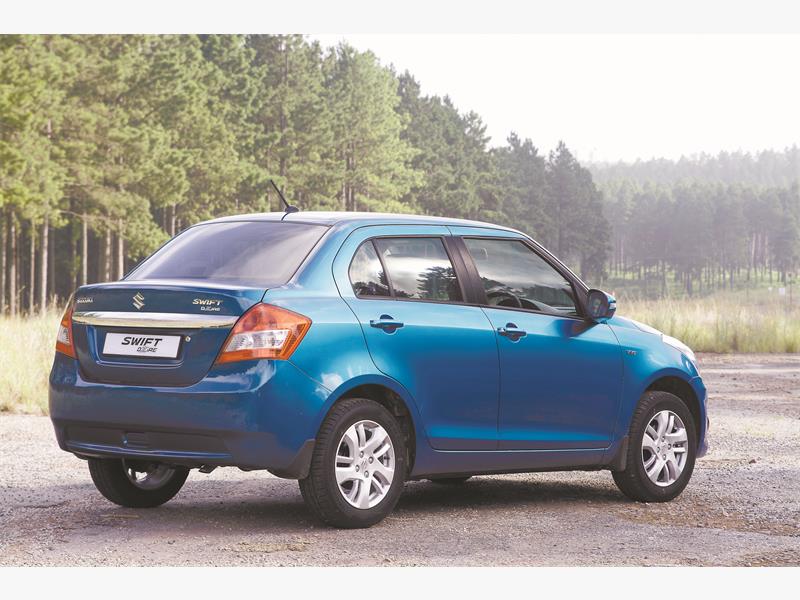Suzuki has added a new sedan model to its popular Swift hatchback range.

The booted derivative will be known as the DZire to distinguish it from the Swift hatchback with which it shares a platform.
Apart from offering the practicality and security of a boot and more space for rear passengers, the DZire is fitted with a new 1,2-litre engine and coupled to a either a five-speed manual or a four-speed automatic gearbox. The derivative we drove at launch was a manual and combined with the four-cylinder, 16-valve engine the package seemed quite adequate. The 1 197 cc is credited with a maximum output of 63 kW at and 113 Nm, but this will of course drop significantly at Gauteng altitudes and the jury is still out on the automatic gearbox.
The five-speed manual transmission proved to be quite appropriate and the car was pleasant to drive, despite the electrically powered rack and pinion steering feeling rather dead.
Swift DZire customers get to choose between GA and GL specification levels, and herein lies my greatest criticism. In order to keep prices down the GA specification level does not include ABS. Suzuki’s argument that this is what customers want does not wash with me. Apart from the fact that many buyers looking at this kind of car will not really understand the importance of ABS, I question whether there should be a choice. Being able to stop more quickly in an emergency could be the difference between life and death for someone other than the person who saved a little money by dumping the ABS. It is time government stepped in and legislated that all new cars be fitted with what is now not even particularly expensive safety equipment. In any event the GA gets dual front airbags, a safety feature more expensive and less significant than ABS, so the cost argument makes no sense.
Built in India the DZire recognises that road conditions in developing nations like ours aren’t always optimal, and so it features a slightly raised ground clearance and high-profile tyres specifically for this reason, thus helping it deal with rutted tar, potholes and gravel surfaces. The ride proved smooth and comfortable and the cabin is relatively spacious both in the front and the back. The 300 litre boot which opens all the way to bumper level, is to my mind a real plus and I would chose it over the hatch any day.
The dashboard’s upper surfaces are finished in black, while the lower part, as well as the upholstery and carpets, are finished in a contrasting light tan hue and is a design trait unique to the DZire. The all black interior of the hatch is to my mind far more attractive and practical, so hopefully Suzuki will allow customers to choose.
The DZire features cup holders mounted in the door side panels, as well as in the centre console. A nifty, quick-release pop-up beverage holder is also provided in front of the passenger side air vent, which will keep the drink cool.
The minimum kerb mass of 960 kg in the case of the manual version, and 990 kg for automatic models, is one of the reasons the DZire maintains an acceptable power-to-weight ratio, which should keep fuel costs down. This should prove to be an important selling point as the fuel price bites into budgets.
The DZire 1.2 Manual is credited with a 0-100 km/h acceleration time of 12,6 seconds, and achieves a top speed of 160 km/h. Combined cycle fuel consumption is said to be 5,7l/100 km, with an associated CO2 emissions figure of 134 g/km. In automatic trim, the DZire uses an extra litre over 100km.
Externally, GL models get blacked-out A and B-pillars, colour-coded door handles, integrated front fog lights and electrically adjustable, colour-coded exterior mirrors with integrated indicators. Front and rear mud flaps are standard, too.
The GL interior reflects its more upmarket status with upgraded seat fabric, and an instrument binnacle that includes a rev counter. The same two-tone theme of black and light tan remains, but the GL benefits from metallic accents on the steering wheel, the inside door handles, the gear shift lever, and the handbrake. A faux wood finisher strip on the dashboard and front door panels adds further lustre.
Included in the GL package is a CD receiver with four loudspeakers, as well as USB and auxiliary sockets for use with portable music devices. The audio system can be controlled via switches on the steering wheel, and is MP3 playback compatible. There are also electric windows, electrically adjustable exterior mirrors, remote central locking and keyless entry.
The recommended retail prices of the new Suzuki Dzire range include a two-year/30 000 km service plan and a three-year/100 000 km warranty, while a three-year/unlimited distance roadside assistance package is also provided as part of the deal. Services are at 15 000 km intervals.









